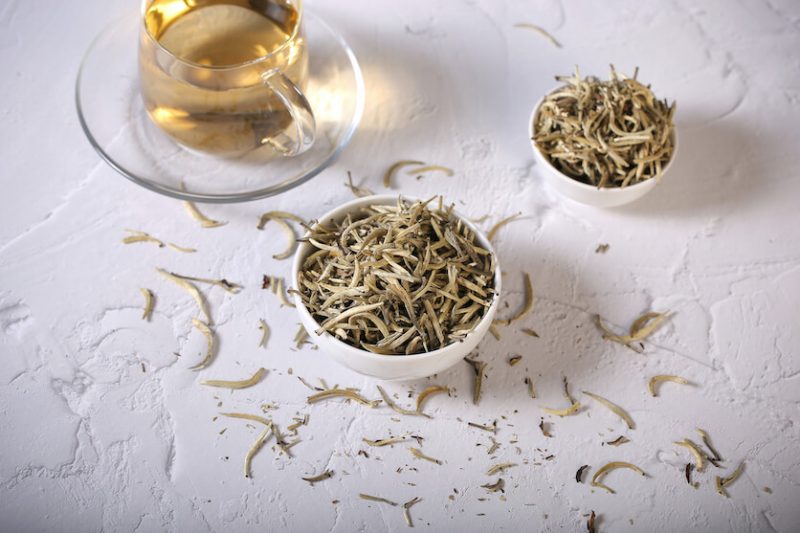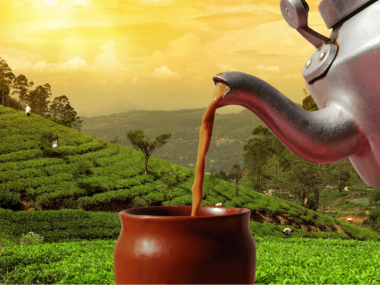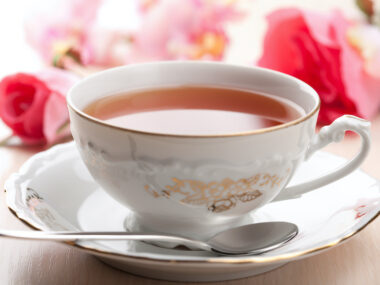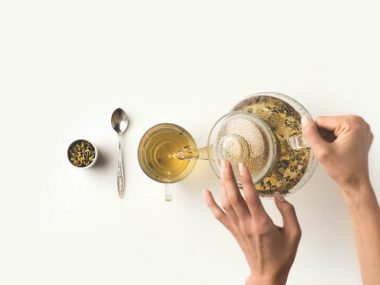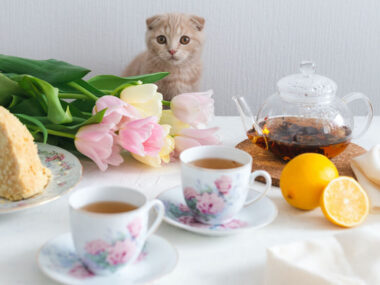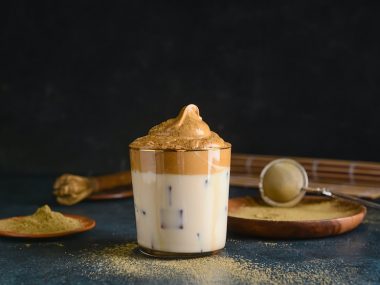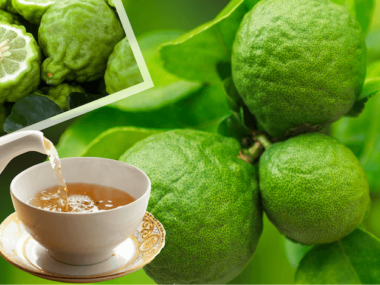Who knew tea had the power to shine like a star or be as pure as the clouds that kiss the tea leaves as they pass by. There’s no other like this one, for it’s pure, rare, and screaming to be in your next cup of tea. Learn more about the fascinating silver needle tea.
Table of Contents
What Is Silver Needle Tea?
Silver Needle tea (“Bai Hao Yin Zen”) is a white tea cultivated and processed mainly in the Fujian Province of China. This tea is made from the tender buds on the tea plant. When processed, these buds are reduced to a needle-like tea (hence the name) covered in tiny white fuzzy hairs. So, let’s dive in and check this “prickly” sounding tea out!
Types Of Silver Needle Tea
White tea from China comes in different types. The growing region depicts its type, quality, overall taste, and price. It’s important to know this to avoid acquiring the wrong Silver Needle tea. When sourcing this tea, be sure to note its origin. The origin can make a big difference in the overall quality of the tea.
The Fujian Province and Yunnan Province of China both grow and process Silver Needle tea. There are several significant differences between the tea from Yunnan compared to its Fujian counterpart.
Fujian Silver Needle Tea Vs. Yunnan Silver Needle Tea
Fujian Province
Fujian Province is located on China’s southeastern coast. It sits across the waters from Taiwan.
Climate
- High elevation with cool temperatures
- Fuding area produces the highest quality of tea
Overall Tea Quality
- Leaves are longer and more silver with a white down
- Uniform in size and shape
Taste
- Fuding Silver Needle Tea: sweet, floral, fruity, smooth
- Zhenghe Silver Needles Tea: savory, smoky, herbaceous
Yunnan Province
Yunnan Province is located in southern China, just above Myanmar and Laos.
Climate
- Low elevation with hot temperatures
Overall Tea Quality
- Leaves are short, thinner, darker, and have less white down
- Lacks uniformity in size and shape
Taste
- Savory
- Smoky
- Woody
- Malty
- Spicy
- Floral
- Fruity
- Astringent
Silver Needle tea may also be aged for as many as seven years or more. Aged Silver Needle tea can be in either a cake form or loose-leaf. As it ages, it takes on a rusty appearance. When brewing the tea, it has a dark color and tastes fruity and spicy.
Cultivation and Processing Of Silver Needle Tea
The major areas within Fujian Province where tea farms grow Silver Needle include Fuding (which produces the highest quality of tea,) Zhenghe, Songxi, and Jianyang. These tea farms are poised at different elevations with varying climates and have their own methods of harvesting (flushes) and processing.
Harvesting (Flush)
Most of this tea is harvested (known as flushes) in early April before the Qing Ming (festival). This flush fetches the highest price because it is the purest tea leaves. The tea plants have been allowed to rest over the summer, fall, and winter. Come Spring, the new tender tea buds are handpicked along with one or two leaves.
A first flush (harvest) produces tea leaves that are much larger, more silver, and have more white down on them (fuzzy hair.) The late April flush (harvest) produces tea leaves that are grayer with a flat appearance compared to the needle-like appearance with the first flush.
What Does Silver Needle Tea Taste Like?
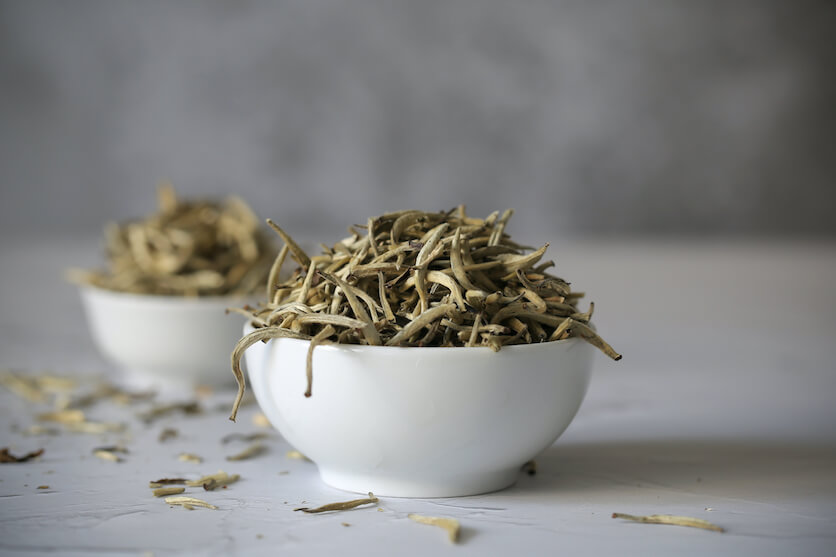
If one were to describe what a cup of Silver Needle tea tastes like, you would most likely hear them claim the tea has a very pure, clear, unadulterated flavor that is simple and uncomplicated. It’s almost like nature is savored in a sip of this tea. For first-time Silver Needle drinkers, that first sip can be pretty emotional.
Why Is Silver Needle Tea So Expensive?
The most expensive Silver Needle tea is grown and processed in the Fuding area (Fujian Province, China.) All Fujian Province Silver Needle teas fetch a high price. But what makes Silver Needle so expensive (regardless of whether it comes from Fuding or any other area in Fujian Province) is the fact that it is harvested and processed by hand (the traditional method). It is very labor-intensive. Also, there are limited harvests making the tea rare.
Cultivation, Harvesting, and Processing of Silver Needle Tea
One of the beautiful aspects of white tea (which includes Silver Needle) is the fact that this tea undergoes minimal processing. This protects the integrity of the tea’s flavor, benefits, and appearance. There are some Silver Needle teas out there that are more processed. They appear to be grayish-brown and have a smoky taste.
Cultivation
Fujian Silver Needle is grown in terroirs (environment/climate) at higher elevations where there are little to no pests/insects, the air is cooler, and the mist of bypassing clouds kiss the tea leaves. Any tea, whether it’s black, green, oolong, yellow or white, grown in these conditions will produce a cup of the finest tea you’ll ever experience.
Harvest (Flush)
Come early April, the tea bud and one leaf are handpicked by tea leaf pickers. This harvest produces a more delicate-tasting tea. The second flush occurs in late April (and in most cases is the last flush until the following year.) This later flush produces a more vibrant, bright-tasting tea.
Processing
The tea leaf pickers bring all of the tea buds to a processing house, where the tea is prepared before going to market.
Withering
The tea leaves are spread out onto a bamboo tray and laid out in the sun for three days to oxidize.
Sorting
The withered tea leaves are hand-tossed into the air from a bamboo tray to sort the small leaves from the large ones. The larger the leaf, the higher the grade and the price.
Fixing
The tea leaves are now baked in wok-like pans over charcoal fires. The tea makers are vigilant to prevent the fire from smoking because it would cause a shift in the flavor of the tea. Once the tea leaves are done baking, they are dried and go on to be packaged or stored for aging.
Does White Tea Have Caffeine?
According to a published research article entitled “Comparison Of The Main Compounds In Fuding White Tea Infusions From Various Tea Types,” Silver Needle Tea’s caffeine increases with brewing temperature. We have broken down their findings to show you.
- 176 degrees (F) (80 degrees C)
- Lowest Caffeine Level
- 0.94 mg caffeine per 6-ounce serving
- 194 degrees (F) (90 degrees C)
- Higher Caffeine Level
- .68 mg caffeine per 6-ounce serving
- 212 degrees (F) (100 degrees C)
- Highest Caffeine Level
- .50 mg caffeine per 6-ounce serving
Can I Drink Silver Needle White Tea Every Day?
As with any tea, we cannot recommend or advise you on whether or not it’s safe to consume daily. We provide evidence-based data to help guide you in making a well-informed decision.
Before drinking tea, it’s best to consult with your healthcare provider if you have any medical conditions or are taking medication. The same applies if you are pregnant or are nursing.
In our research, there’s no scientifically backed information clearly stating white tea (including Silver Needle) as being unsafe to drink daily.
White Silver Needle Tea Benefits
Silver Needle tea is packed with health benefits because it has been minimally processed. The beneficial constituents in the tea are preserved, making it a lovely tea that tastes good and is healthy.
What Is Silver Needle Tea Good For?
According to the International Journal of Food Science, Nutrition, and Dietetics, the phenols in white tea are high. These phenols act as antidiabetic, antidepressant, antimicrobial, antihypertensive, anti-inflammatory, and antioxidant and help in weight loss while reducing the risk of cardiovascular disorders/disease and neurological degeneration.
How To Brew Silver Needle Tea
If you have purchased some of this luxurious tea, you may be wondering, “How do you drink silver needle tea and brew it the right way?” We will walk you through how to make the perfect cup of tea. And as far as “How many times can you steep Silver Needle tea?” well, that would be up to three brews before the tea is spent.
Ingredients
- 2 cups of water
- 2 teaspoons of loose-leaf Silver Needle tea
Directions
- Heat the water until it reaches about 175 degrees (F) (80 degrees C.)
- Remove from the heat.
- Place the loose-leaf tea into a tea infuser.
- Drop the infuser into a teapot.
- Pour the hot water into the teapot.
- Place the cover on and allow it to steep for 3 minutes.
- Remove the teapot cover and the tea infuser.
- Pour the tea into a teacup and enjoy!
Pairing Tip: Silver Needle tea is a lovely tea to enjoy with a rich, chocolate dessert such as chocolate lava cake or a luscious piece of fudge!
This Tea Has A Definite Silver Lining
There’s only a handful of teas that we get super excited about, and this is one of them! A cup of Silver Needle is as close to a liquid diamond in a cup you will ever get. Make it a must-try on your tea journey.
